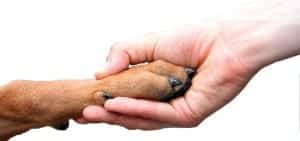“It is the intuitive power of animals that can help us heal hurts, lessen stress, feel needed, and express our caring side.” Marty Becker, DVM, Resident veterinarian on Good Morning America
Why do people have pets that they feed, walk, play with, and take care of in the same way that might care for a child? Companionship is something that we all long for. Although they were not the perfect match for Adam- before Eve, he was given the task of spending time with and naming all the animals that God had placed around him (Genesis 2:19-20). Companionship was important from the beginning! After all, we were made for it and depend on it for our well-being.
Animal Assisted Therapy (AAT) began in the early 1990s. Since then, however, it has grown in popularity and has gained wide acceptance and is evolving into mainstream psychology. One well-recognized organization in this field explains the process: “The therapy will look much the same as a “traditional” session, except with AAT there is a friendly, calm animal in the room. Sometimes just the presence of the animal creates and facilitates an environment that is conducive to the counseling process. In other cases the therapist will design specific interventions where the client and animal are interacting in some way in order to meet a specific therapeutic goal. For some clients, such as children, adolescents and seniors, the presence of a therapeutic animal can facilitate communication and help ease some of the anxiety or resistance sometimes present,” (www.animalassistedtherapyprograms.org).
Why should I consider this option? Who is AAT best suited for? What are the benefits of this form of therapy? I’m glad you asked! The benefits of AAT are innumerable and diverse, but here are 10 that are related to effective progress in therapy.
1. Reduction in blood pressure
“Vormbrock and Grossberg (1988) assessed heart rate and blood pressure while undergraduates interacted with a dog visually, verbally, or tactually. Blood pressure was highest while talking to the experimenter and lowest during stroking the dog.”
2. Lowered stress and anxiety levels
“Odendaal and Meintjes (2003) assessed changes in plasma cortisol [stress hormone] in dog owners when petting their own, or an unfamiliar dog, or quietly reading a book. The interaction with their own dog, and also with the unfamiliar dog, but not the reading condition led to a significant decrease in the cortisol levels of the humans.”
3. Enhanced self esteem
“AAT also allows children an outlet for the loving part of themselves and helps them control and regulate their own behavior while developing empathy toward other living creatures (Gonski, 1985). Through successes with the animal, many children are able to increase their self-esteem and thereby have more confidence when approaching new tasks.”
4. Increased emotional awareness and regulation
“In psychiatric inpatients, however, AAT lead to a significant increase in interactions with other patients over the course of 4 weeks in comparison to rehabilitation without animals. This included smiles, sociability, helpfulness toward others, activation and responsiveness (Marr et al., 2000).”
5. Reduced aggression
“Effects of the presence of friendly dogs on aggressive behavior in a classroom of first-graders were investigated via behavior observation and reports of the classroom teacher (Hergovich et al.,2002; Kotrschal and Ortbauer, 2003). In the presence of the dog, in comparison to its absence, aggressive behavior was decreased.
6. Reduced loneliness
“Wells (2004) studied the behavior of 1800 strangers toward a female experimenter in six different conditions: accompanied by a Labrador retriever pup, by an adult Labrador, by an adult Rottweiler, being in the presence of a teddy bear or a plant, or being alone as control conditions. In the alone condition, the experimenter was ignored more than with the teddy or plant, but got more attention in the company of a dog. The Rottweiler led to more non-responses than the pup or the adult Labrador, which elicited most smiles and verbal responses.”
7. Improved immune system
“Only one study assessing parameters of the immune system met our inclusion criteria. Charnetski et al. (2004) reported a significant increase in salivary immunoglobulin A (IgA), an indicator of good immune system functioning, in college students after stroking a live dog in comparison to stroking a stuffed dog or sitting quietly for 18 min.”
8. Increased trust and trustworthiness
“Gueguen and Cicotti (2008) investigated the influence of the presence or absence of a dog on social interaction, helping, and courtship behavior. In four different experiments, experimenters asked strangers for money in the street, young women for their phone numbers in public or observed whether people would help to pick up coins a male experimenter dropped on the street. The presence of the dog was linked to a higher compliance with the request for the phone number and a higher rate of helping behavior. In particular the compliance with the request for the phone number can be interpreted as an indication for increased trust and maybe also attraction of the strangers toward an unfamiliar man accompanied by a dog, which probably promoted his perception as a trustworthy person. These first findings indicate a sociopositive effect of dogs on trust and prosocial behavior”
9. Reduction of depression
“Elderly residents of an institution experienced a reduction in depression and improvement in quality of life when caring for a canary for a period of 3 months (Colombo et al., 2006). A companion bird also reduced depression in elderly adults after admission to a skilled rehabilitation unit (Jessen et al., 1996).”
10. Stimulates positive communication
“An unexpected benefit included an increase number of spontaneous communication initiations produced during sessions; dog may act as a unique catalyst to motivate client and provide an atmosphere of unconditional acceptance for disordered speech.”
As you can see, it is advantageous to pursue AAT as a therapeutic option because of the positive physical, mental, and emotional effects on the body. For more information about how to get involved in this form of therapy, follow this link:https://christiancounselingco.com/our-services/animal-assisted-therapy/.
References:
(Cardiovascular effects of human-pet dog interactions. Vormbrock JK, Grossberg JM J Behav Med. 1988 Oct; 11(5):509-17.)
(Neurophysiological correlates of affiliative behaviour between humans and dogs. Odendaal JS, Meintjes RA Vet J. 2003 May; 165(3):296-301.)
(Gonski, Y (1985). The therapeutic utilization of canines in a child welfare setting. Child Adolescent Social Work J. 2(2), 93-105.)
(Marr C. A., French L., Thompson D., Drum L., Greening G., Mormon J., Hughes C. W. (2000). Animal-assisted therapy in psychiatric rehabilitation. Anthrozoos 13, 43–3710.2752/089279300786999950)
(Hergovich A., Monshi B., Semmler G., Zieglmayer V. (2002). The effects of the presence of a dog in the classroom. Anthrozoos 15, 37–5010.2752/089279302786992775; Kotrschal K., Ortbauer B. (2003). Behavioral effects of the presence of a dog in a classroom. Anthrozoos 16, 147–15910.2752/089279303786992170)
(Wells D. L. (2004). The facilitation of social interactions by domestic dogs. Anthrozoos 17, 340–35210.2752/089279304785643203)
(Effect of petting a dog on immune system function. Charnetski CJ, Riggers S, Brennan FX Psychol Rep. 2004 Dec; 95(3 Pt 2):1087-91.)
(Gueguen N., Cicotti S. (2008). Domestic dogs as facilitators in social interaction: an evaluation of helping and courtship behaviors.Anthrozoos 21, 339–34910.2752/175303708X371564)
(Pet therapy and institutionalized elderly: a study on 144 cognitively unimpaired subjects. Colombo G, Buono MD, Smania K, Raviola R, De Leo D Arch Gerontol Geriatr. 2006 Mar-Apr; 42(2):207-16.; Avian companionship in alleviation of depression, loneliness, and low morale of older adults in skilled rehabilitation units. Jessen J, Cardiello F, Baun MM Psychol Rep. 1996 Feb; 78(1):339-48.)
(Macauley, B. L. (2006). Animal-assisted therapy for persons with aphasia: A pilot study. Journal of rehabilitation research and development, 43(3), 357).
(Beetz, A., Uvnäs-Moberg, K., Julius, H., & Kotrschal, K. (2012). Psychosocial and Psychophysiological Effects of Human-Animal Interactions: The Possible Role of Oxytocin. Frontiers in Psychology, 3, 234. doi:10.3389/fpsyg.2012.00234)



